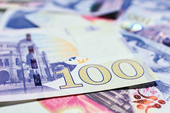Causes for Georgian currency devaluation
By Tea Mariamidze
Tuesday, July 2


At present, according to the National Bank of Georgia (NBG) rate, one US Dollar equals GEL 2.8687, while one Euro costs GEL 3.2657.
Georgian authorities claim GEL will gain value in the future, adding the recent depreciation is the result of the worsened relations with Russia and negative expectations.
Georgia’s Minister of Economy and Sustainable Development, Natia Turnava, says that Georgian national currency will be stable on a long-term perspective. She noted that Russia’s embargo on the direct flights with Georgia negatively reflected on the exchange rate, because the ban hit tourism, the largest sector of foreign currency inflow in Georgia.
“According to her, macroeconomic parameter shows that GEL rate will not depreciate in a long-term perspective,” she said.
Minister of Finance, Ivane Machavariani, also commented on GEL rate. He said the situation on the local currency market is a reflection of the recent developments and negative expectations that have been taking place across the country recently.
“I hope, these expectations will not come true in the full scale,” he stated.
Experts say that the ban that will take effect on July 8 has yet slightly affected Georgian economy, but they expect much worse situation.
The analysts believe GEL has suffered double damage – Russian ban and protests across the country. The claim if the demonstrations continue, GEL will be even more affected.
The National Bank of Georgia says the exchange rate is affected by internal and external factors, including expectations and reduction of tourism flows from Russia was reflected in the currency market in recent days.
Paata Bairakhtari, Vice-President of the Young Businessmen and Financiers Association, says GEL started devaluation in May and established the first anti-code - the cost of 1 dollar for the first time was 2,80 GEL.
“The second anti-record was established on the Bloomberg platform on June 28 when 1 dollar was traded at 2.86 GEL…If we have a look at the second wave, we see that sharp depreciation of GEL started on the next day of the announced sanctions,” he said.
Giorgi Kepuladze, Founder of Society and Banks, says in a week after the Russian ban it is impossible to have such an effect on the national currency. He believes the main factor is negative expectations, especially after Putin’s statement regarding travel embargo with Georgia.
“We also see some signs of panic on the market…If this panic is over, GEL can return to its regular rate of 2.70-2.75 per US Dollar.
Economist Akaki Tsomaia says in parallel with the ban on flights from Russia, Foreign Direct Investments have reduced in Georgia.
“This is dangerous for the Georgian economy…According to the current picture in the country, I cannot have positive expectations,” the analyst stressed.
To note, Russian President Vladimir Putin signed a decree on June 21 banning Russian airlines from flying to Georgia from July 8 in response to anti-Moscow rallies in Tbilisi.
